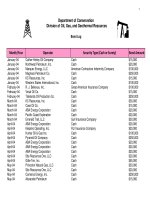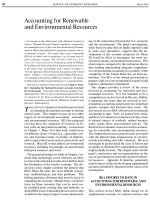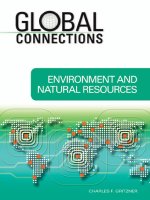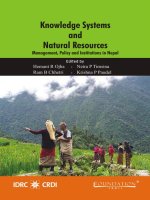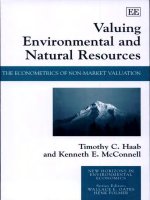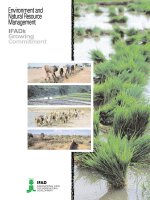ENVIRONMENT AND NATURAL RESOURCES doc
Bạn đang xem bản rút gọn của tài liệu. Xem và tải ngay bản đầy đủ của tài liệu tại đây (13.3 MB, 120 trang )
ENVIRONMENT AND
NATURAL RESOURCES
GC_EnvNatRes.FNL.indd 1 12/21/09 4:41:17 PM
GLBAL CNNECTINS
America’s Role in a Changing World
Changing Climates
The Changing Global Economy
Environment and Natural Resources
Feeding a Hungry World
The Human Population
Human Rights
One World or Many?
Pandemics and Global Health
Terrorism and Security
ENVIRONMENT AND
NATURAL RESOURCES
CHARLES F. GRITZNER
GC_EnvNatRes.FNL.indd 3 12/21/09 4:41:18 PM
Environment and Natural Resources
Copyright 2010 by Infobase Publishing
All rights reserved. No part of this book may be reproduced or utilized in
any form or by any means, electronic or mechanical, including photocopy-
ing, recording, or by any information storage or retrieval systems, without
permission in writing from the publisher. For information contact:
Chelsea House
An imprint of Infobase Publishing
132 West 31st Street
New York, NY 10001
Library of Congress Cataloging-in-Publication Data
Gritzner, Charles F.
Environment and natural resources / by Charles F. Gritzner.
p. cm. (Global connections)
Includes bibliographical references and index.
ISBN 978-1-60413-289-2 (hardcover)
ISBN 978-1-4381-3166-5 (e-book)
1. Environmental sciences Juvenile literature. 2. Natural resources
Juvenile literature. I. Title. II. Series.
GE115.G75 2010
304.2 dc22
2009033602
Chelsea House books are available at special discounts when purchased in
bulk quantities for businesses, associations, institutions, or sales promotions.
Please call our Special Sales Department in New York at (212) 967-8800 or
(800) 322-8755.
You can fi nd Chelsea House on the World Wide Web
at
Text design by Annie O’Donnell
Cover design by Takeshi Takahashi
Composition by EJB Publishing Services
Cover printed by Bang Printing, Brainerd, MN
Book printed and bound by Bang Printing, Brainerd, MN
Date printed: February 2010
Printed in the United States of America
10 9 8 7 6 5 4 3 2 1
This book is printed on acid-free paper.
All links and Web addresses were checked and verifi ed to be correct at
the time of publication. Because of the dynamic nature of the Web, some
addresses and links may have changed since publication and may no
longer be valid.
GC_EnvNatRes.FNL.indd 4 3/3/10 11:59:48 AM
CONTENTS
CONTENTS
Introduction: A Global Community 7
1 Our Planetary Spaceship 9
2 Humans, Environment, and Resources 17
3 Earth’s Atmosphere 33
4 Land Features 48
5 Water Features 68
6 Plant and Animal Life 85
7 Minerals and Fossil Fuels 99
8 Environment, Resources, and
the Future 110
Glossary 115
B
ibliography 116
F
urther Resources 117
P
icture Credits 118
I
ndex 119
A
bout the Author 125
GC_EnvNatRes.FNL.indd 5 12/21/09 4:41:20 PM
7
INTRoduCTIoN
A GLoBAL
CoMMuNITy
G
lobalization is the process of coming together as a closely
connected global community. It began thousands of years
ago, when tribal groups and small hunting parties wandered from
place to place. The process accelerated following Columbus’s epic
voyage more than five centuries ago. Europeans—an estimated
50 million of them—spread out to occupy lands throughout the
world. This migration transformed the distribution of the world’s
peoples and their cultures forever. In the United States and Can-
ada, for example, most people speak a West European language.
Most practice a religious faith with roots in the ancient Middle
East and eat foods originating in Asia.
Today, we are citizens of a closely interwoven global com-
munity. Events occurring half a world away can be watched and
experienced, often as they happen, in our own homes. People,
materials, and even diseases can be transported from continent
to continent in a single day, thanks to jet planes. Electronic com-
munications make possible the instantaneous exchange of infor-
mation by phone, e-mail, or other means with friends or business
ENvIRoNMENT ANd NATuRAL RESouRCES
8
associates almost anywhere in the world. Trade and commerce,
perhaps more so than any other aspect of our daily lives, amply
illustrate the importance of global linkages. How many things in
your home (including your clothing) are of international origin?
What foods and beverages have you consumed today that came
from other lands? Could Northern America’s economy survive
without foreign oil, iron ore, copper, or other vital resources?
The G
lobal ConneCtions series is designed to help you real-
ize how closely people and places are tied to one another within
the expanding global community. Each book introduces you to
political, economic, environmental, social, medical, and other
timely issues, problems, and prospects. The authors and editors
hope you enjoy and learn from these books. May they hand you
a passport to intellectual travels throughout our fascinating,
complex, and increasingly “intradependent” world!
—Charles F. Gritzner
Series Editor
9
ouR PLANETARy
SPACESHIP
W
hen seen from a distant vantage point, Earth appears as a
small, fragile planet suspended in the vastness of space.
The planet’s mosaic of different colors, surface shapes, swirls,
and textures gives it the appearance of a marble wandering about
the heavens. Yet this small dot in space is our home—“Spaceship
Earth.” And within at least the solar system, it is a unique place
in countless ways.
Like a spaceship, Earth is a self-contained “capsule.” Other
than solar energy and occasional debris from space, such as
meteors and their dust, nothing is added to our planetary space
capsule. And very little leaves it. Yet this amazing place has a
natural environment that supports humankind—nearly 7 billion
of us. The contents of our space capsule provide the nutrients,
energy, and other materials that sustain us. Without Earth’s land
and water, plants and animals, air and fuels, there could be no
human life. These elements are the natural resources, the things
that we use to survive, build, and grow. In this book, you will
1
ENvIRoNMENT ANd NATuRAL RESouRCES
10
learn about Earth’s different natural environments. You will also
see how we culturally adapt to, use, and change our planet’s ele-
ments and conditions.
THE NATuRAL ENvIRoNMENT
The environment refers to everything that surrounds us. Some
things are natural in origin. Together, they are the elements that
Planet Earth is a self-sustaining capsule that contains all that is needed
to support billions of lives.
11
our Planetary Spaceship
make up the natural environment. They include terrain, or land
features such as plains, valleys, and uplands. Soils are a very
important part of the environment in many places. So are mineral
resources such as fuel, metals, and building materials. Weather
and climate help shape the environment. They strongly influence,
for example, what kind of wild plant and animal life a place will
have. Many freshwater features, too, reflect a region’s climate.
In most places on Earth’s surface, we are also surrounded by
things of human origin. They include towns and cities, homes
and other structures, farms and fences, and transportation
routes. All features created by humans are part of the cultural
environment. Throughout this book, emphasis is on the natural
environment and the natural landscapes created by various envi-
ronmental conditions. You must remember, however, that most
cultural environments and cultural landscapes are created as
humans use and change natural elements.
Throughout this book, reference will be made to natural land-
scapes. Think of landscape as a “picture.” It is what you actu-
ally see within a particular environmental setting. Look out the
window. What do you see? Almost certainly, you see a landscape
formed by both natural and cultural environmental features.
How many things that you see involved humans using, hence
changing, natural elements? (Don’t forget to include things such
as fields, concrete sidewalks and streets, planted vegetation, and
building materials.)
Unless you are completely surrounded by an urban (city)
landscape, you can see many things that are a part of the natural
environment. They may, of course, have been changed by human
activity. The sky, for example, may have smoke and other pollut-
ants that create a haze. Trees may be planted in neat rows, and
flowering plants may be arranged in a garden that has improved
soil and a built-in sprinkler system. Land may have been cut
away, leveled, or filled in to allow structures to be built. Water
may be controlled in some way, whether channeled or confined
in a lake, pond, or fountain.
ENvIRoNMENT ANd NATuRAL RESouRCES
12
The natural environment can be divided into four “spheres,”
or realms. Earth’s solid portion forms the lithosphere. It includes
all land features, soils, and minerals. Twenty-nine percent of
Earth’s surface is composed of lithosphere. Seen from space,
much of Earth’s surface (71 percent) is covered by water. There
is so much water, in fact, that Earth has earned the nicknamed
“the Blue Planet.” Water features, both saline and fresh, form the
hydrosphere. Surrounding the planet is a thin layer of air, water
vapor, dust, and other impurities. This blanketing envelope is
The Global “SupermarkeT”
Earth—our planetary “spaceship”—is like a giant supermarket in many
ways. Both the planet and a grocery store possess a vast number of
varied items. But for many reasons, not everyone wants or is able to
take advantage of everything the store offers. In a store, a vegetarian
will avoid the meat counter. Someone who doesn’t drink alcohol will
not be found in the liquor aisle. Those with limited incomes will not
fill their shopping cart with items from the gourmet section. Many
people simply do not know what to do with certain items. (Would you
know what to do with squid, saffron, or manioc tubers?) Personal
perceptions (tastes and needs) also play an important role. They can
greatly influence what people will select in a store or from the natural
environment.
A similar situation exists in terms of the ways in which humans,
as cultural groups, interact with nature. Our needs, knowledge, tools,
and skills greatly influence what a people will, or will not, do within a
certain environmental setting. In Brazil’s Amazon Basin, for example,
some people live simple lives. They hunt, fish, and gather and do
little to change the environment. Farmers, ranchers, and miners, on
the other hand, destroy the forest. But each group focuses upon a
13
Our Planetary Spaceship
the atmosphere. It is responsible for all of our weather, climate,
and storms. Finally, there are the plants and animals that make
up the biosphere.
NATURAL RESOURCES
Everything upon which humans depend for survival comes from
the elements contained within Earth’s four spheres. We cannot
add to them. Through time, however, we have greatly expanded
different natural element. Farmers depend upon the soil; ranchers rely
upon grass and forage for their livestock; miners see Earth’s minerals
as their key to wealth.
In most supermarkets, very little if any of what they contain is
produced locally. So, too, many of Earth’s nearly 7 billion people
depend upon resources from many different locations. If the store
does not stock something you want, you can ask the manager to
order it for you. In this way, each of us depends upon far-flung global
connections to provide many if not most of the things upon which
we depend daily.
How many items that you have used, consumed, or otherwise
come in contact with today are the product of one or more natu-
ral resources? Can you identify the origin of these resources? For
example, where did the gasoline that powers your vehicle come
from? Where did the various metals in the vehicle come from? Do
you have a cell phone? If you do, are you aware that it contains
coltan, a mineral almost certainly mined in the Democratic Republic
of Congo, a country in Central Africa? The phone also contains tin,
more than one-third of which is produced in the Congo. Could every-
one in the world today enjoy all of the things that you use and take
for granted? Why, or why not?
ENvIRoNMENT ANd NATuRAL RESouRCES
14
their potential use to humans. Once we realize that something
can be of use, a way must be found to obtain it. Once a natural
element is used, it becomes a natural resource.
Many, if not most, natural resources are changed in some
way to make them more useful to us. Take, for example, this
book. The paper, no doubt, was made from wood, perhaps by a
process that also used clay. Ink, according to one definition, “is
a complex medium consisting of comprising solvents, pigments,
dyes, resins, lubricants, solubilizers, surficants, particulate mat-
ter, fluorescers, and other materials.” (The author doesn’t know
what all of those items are, either, but the passage suggests that
many natural elements were used to create the ink.) The impor-
tant point is that several natural elements became useful natural
resources. In turn, the resources were changed in some way to
make them more useful. In this case wood and a variety of other
elements became the book that you are reading and the ink with
which it is printed.
ENvIRoNMENTAL CHANGE
Today, nearly everyone is concerned about “the environment.”
We hear a great deal, for example, about global warming and
its possible consequences. Environmental pollution, it seems, is
fouling the land, water, and air throughout much of the world.
Deforestation in the Amazon Basin and elsewhere is a huge prob-
lem. In many areas, including Australia and much of the western
United States, the water supply is a major concern. Soils in many
places have eroded away or become less fertile because of poor
farming practices. Many of Africa’s magnificent large animals
are threatened by humans. The list goes on and on.
From the dawn of human history, humans have changed the
environments in which they live. We breathe the air, drink the
water, and eat plant and animal life. Each of these is taken from
the natural environment. In turn, we pollute the environment
15
Our Planetary Spaceship
when we exhale, or rid our body of wastes. When we walk on
the land, we compact the soil and squash small plants and other
organisms beneath our feet. As you can see, from the very begin-
ning, humans have been active agents of environmental change.
Today, of course, we change the environment in ways unheard
of even several decades ago. This is possible because culture—
particularly technology—has advanced in ways that make Earth
and its elements much more useful to us. And, of course, we have
many more cultural needs today than in the past. (Humankind’s
biological needs have remained constant through time. What has
changed is the way these needs are satisfied.)
Not all environmental change is bad. In fact, without it you
would not be alive. Humans must do everything possible, however,
to ensure that Earth and its resources are used in a way that is sus-
tainable. That is, the planet and its environments and resources
will continue to be available and productive indefinitely.
MAPPING OUR COURSE
This book is designed to give you a much better understanding
of the importance of Earth’s various environmental elements. It
also emphasizes the role that culture plays in the relationship
between humans and the environment. Of particular importance
are the needs, knowledge, tools, skills, and capital resources pos-
sessed by a people. These factors help determine what people do,
or are unable to do, in a particular environment. The traditional
Inuit (Eskimo), for example, did not have a need for Alaska’s oil;
in fact, they were unaware of its existence. Today, Phoenix, Ari-
zona, and Las Vegas, Nevada, are the two fastest-growing large
U.S. cities. Without massive water control and diversion, neither
community could have experienced such explosive growth.
And how many people would want to live in the scorching des-
ert without air-conditioning? As you can see, culture is more
important than the environment in establishing the way people
ENvIRoNMENT ANd NATuRAL RESouRCES
16
actually live and what they do. We will return to this theme time
after time throughout this book.
Chapter 2 introduces some of the basic ideas that explain
the relationship between humans and Earth’s natural environ-
ments. You will examine how different cultures adapt to, use,
and change the environments in which they live. You will learn,
for example, that the environment and its potentials are not
the same to everyone. Some cultures depend upon one or more
resources in a location, while others ignore it (or them) entirely.
Finally, it will discuss ways in which humans create unique cul-
tural landscapes. All human societies change the environment to
fit their own needs and desires.
In chapters 3 through 7, you will learn how Earth’s environ-
mental elements are important to humans. Each element will be
discussed individually in terms of its nature and distribution. Each
of them will also be looked at as an environmental hazard—how it
can threaten humans. Finally, attention will be given to its use by
humans, that is, its importance as a natural resource.
Finally, in Chapter 8, we will attempt to take a peek into the
future. The human population is expected to grow to around
9 billion people by mid-century. Will there be enough natural
resources to go around? Will there be enough food? Will new
resources be found to replace those that are depleted? What
impact will a population half again as large as today’s have on
Earth’s fragile natural landscapes? These are just some of the
questions that this book raises and attempts to answer.
1
7
HuMANS,
ENvIRoNMENT,
ANd RESouRCES
I
magine for a moment that you lived 25,000 years ago. What use
could you have made of the environment in which you lived? You
had little awareness of what was there. Basically, you knew only of
those things that you could see. Little did you know, for example,
that a huge reservoir of water was stored in the ground deep below
the surface. Or that a deposit of oil (iron ore, copper, zinc, lead,
gold . . . you get the idea!) was waiting to be tapped. (Of course,
it would be more than 24,800 years before a major use would be
found for oil.) And if you were aware of some metal, such as raw
copper, could you have used it? How would you have obtained the
resources that we take for granted today? Even if you were aware of
something like iron ore, copper, or lead, could you have processed
it? And if you did, how would you have used the metal?
HuMAN uSE oF THE EARTH
Knowing that something “is there” is only a first step toward
it actually being used. Twenty-five thousand years ago, what
2
ENvIRoNMENT ANd NATuRAL RESouRCES
18
knowledge did people possess that allowed them to use the
various natural elements within their environment to their
advantage? Basically, they were aware of and used what was
immediately available. And those things they did use were little
changed from their natural state. For example, early humans
used such things as wood, bark, stones, animal skins, and
earth to build shelters. Their clothing may have been made
from animal skins. The tools and weapons that they used were
crafted from wood, stone, or bone. Everything they used was
local in origin and used in pretty much the same condition in
which it was found.
Of course, they breathed the fresh air. And the water upon
which their life depended came straight out of a lake or a stream
that flowed by their campsite. They hunted, fished, and gathered
to obtain their food. If game was scarce, or the roots, fruits, nuts,
and berries upon which people depended were in short supply,
they went hungry. Starvation, it seemed, was never more than
a step or two away. They lived very close to nature. And they
lacked the knowledge, tools, and skills to greatly change what
nature provided.
Now, think of the things that you will use, or otherwise come
in contact with, today. What about your home? Of what materi-
als is it made? Perhaps there is wood, stone, and clay (bricks or
adobe). The plumbing may be made from plastic or some metal,
and the wires, no doubt, are made from copper. Windows are
made of glass (sand). Depending upon the kind, roofing can
be made of many components. How many of these items are in
their original natural form? In all probability, not a single one is!
How were these natural elements—things taken from nature—
changed to make them more useful? Where did they come from?
Were any of the items produced locally, or did they come from
distant locations, perhaps even another continent? The same
questions can be asked about your vehicle, TV set, computer, or
clothing that you are wearing.
19
Humans, Environment, and Resources
In these very brief introductory passages, you have learned
the basic nature of the age-old “man-land” relationship. Today,
scientists call this relationship cultural (or human) ecology.
Humans, after all, have many basic needs. In order to survive,
we must have food and water. We must be protected against cold
and other harsh natural elements. And we must have mobility
for ourselves and the material things upon which we depend for
our survival. But think for a moment about the huge differences
in what people had long ago and what we have today. The dif-
ference is explained by culture. Simply stated, what we know,
possess, and are able to do today is vastly greater than what
humans knew, had, and could do thousands of years ago. The
environment, for all practical purposes, is little changed in terms
of what it offers. What has changed, and changed greatly, is our
knowledge. We have a much greater understanding of Earth’s
elements and conditions and ways in which they can be used.
Of even greater importance has been the development
through time of tools and skills needed to put nature to work for
us. They have made it possible for us to change environmental
elements in many ways. In so doing, we make them more use-
ful. For example, a plain black rock, coal is used in more than
100,000 ways today. From electrical energy to fuel, and aspirin to
plastics, coal is transformed into thousands of different products.
Finally, as we live in and use the environment and its resources,
we change Earth’s natural landscapes. We will return to these
important concepts many times throughout the book.
HOW DO HUMANS “ADAPT” TO NATURE?
Humans are animals. We are creatures within the animal king-
dom and, as such, we are subject to the laws of nature. Every
living organism—be it plant or animal—must adapt in some
way to the natural environment. If they are unable to do this,
they die. Human beings, for example, are tropical animals. Our
ENVIRONMENT AND NATURAL RESOURCES
20
bodies begin to suffer from hypothermia (react to cold) when the
temperature drops into the mid-70s (around 24°C).
There is a huge difference, however, in the way humans and
nonhuman animals adapt to nature. All creatures within the
animal kingdom are biologically (physically) adapted to nature.
In response to cold, for example, some species of wildlife will
migrate while others hibernate. Still others grow an extra layer of
dense fur or body fat to protect against frigid winter conditions.
Each wild creature creates or finds some kind of shelter. It may
be an elaborate nest as built by various bird species, or a simple
hole created by burrowing in the ground. The beaver fells trees
in order to build a dam (hence, create a reservoir) and construct
a snug lodge.
Regardless of what wild animals do, they do it instinctively.
Their actions are programmed genetically or by natural forces
that they inherit, and they cannot be changed. An animal that
burrows, for example, will not suddenly decide to migrate south
for the winter.
Culture as Humankind’s Adaptive Mechanism
Unlike any other form of life, culture is humankind’s adaptive
mechanism. We learn how to survive in various environments.
This morning, for example, the temperature outside the author’s
home was -22°F (-30°C). Outside and with body unprotected,
life expectancy would be a matter of only minutes. There is no
gene in the human body that prepares us to survive a cold snap.
It is our knowledge that allows us to create those things that
must be done to survive harsh conditions. So the author was
able to benefit from centuries of know-how. His home is well
built and well insulated. It has a very effective central heating
system. And when one lives in South Dakota, he or she has
plenty of warm clothing!
Through time, several “influencing factors” have been sug-
gested to explain the relationship between humans and the
natural environment. Until the early twentieth century, some
21
Humans, Environment, and Resources
scholars believed that nature called the shots. This theory,
called environmental determinism, held that humans were
mere putty in the hands of nature. All people living in deserts
(or tropical rain forests, polar regions, and so forth) lived pretty
much the same way and did the same things. It takes only a
basic understanding of world geography to see the flaw in this
notion. In each of the regions cited above, for example, levels
of cultural development range from among the world’s most
traditional to the most advanced.
Another view of the relationship is called possibilism. This
idea was developed by French geographers during the late
Humans adapt to changing environments in ways different from non-
human animals. When cold temperatures hit, most humans simply turn
on the heat and unpack their hats and scarves. Animals, on the other
hand, may burrow in the ground and hibernate or move to a warmer
climate for the winter. These migrating black birds fly through North
Carolina on their way farther south.
ENvIRoNMENT ANd NATuRAL RESouRCES
22
nineteenth century. It points to both the environment and cul-
ture as playing an important role in what people do and how
they live within a particular setting. Possibilism suggests that
the environment establishes limits to what is possible. But within
those limits, humans, based upon their culture, have options.
To better understand the major flaw of this line of thinking,
return for a moment to “The Global ‘Supermarket’” example
from the last chapter. Did the environment (the store itself, or
surrounding physical conditions) limit the groceries and other
items that the supermarket offered? Where did they come from?
Most countries and cultures in the world illustrate that possibil-
ism simply doesn’t work. Japan, for example, is the world’s sec-
ond leading industrial power. Yet fully 97 percent of the natural
resources and raw materials used in Japanese industry must be
imported. Is it the country’s natural environment or its dynamic
culture and work ethic that makes success “possible”?
For more than a century, cultural anthropologists and geogra-
phers have turned to a third explanation of the people-environ-
ment relationship. It is one that places the emphasis on people:
their culture. Ultimately, it is culture that determines what people
will do (or will not be able to do) within an environment. How
else can one explain, for example, desert dwellers? Traditionally,
the belief was that the arid environment limited their options.
They could be oasis farmers or camel herders, or live in a city.
That was about it! Some desert people, of course, are involved
in these activities. In North Africa, for example, traditional Bed-
ouin, Tuareg, and Berber tribes herd livestock. Throughout much
of North Africa and the Middle East, millions of desert-dwelling
people depend upon oasis irrigation. But what about glittering
Las Vegas, Nevada, and booming Phoenix, Arizona? They are the
two driest cities of any size in America and also the two most
rapidly growing. Las Vegas depends upon gambling and other
forms of tourism. Phoenix depends largely upon service-based
industries. Does the economy or way of life of either community
depend upon desert conditions? The answer, of course, is “No!”
23
Humans, Environment, and Resources
Let’s return for a moment to early humans in what most
scientists believe to have been the original homeland of human-
kind—equatorial East Africa. The region’s climate is hot and
humid. Plant and animal life is abundant throughout the year.
Ample rainfall ensures that fresh water is always available. In
the rain forest, there were no large, fierce, potentially deadly
predators like lions or hyenas to threaten early humans. Nature
provided an ample year-round supply of food and water. There
was no need for well-built shelters or elaborate clothing to protect
against the elements. This is the habitat (environment) to which
humans are biologically adapted.
Today, however, humans have made a home for themselves
in all of the world’s climates and ecosystems. It is their culture
that has made this possible. In terms of “influences,” the United
States is unique. It is the only country in the world that includes
within its territory all of Earth’s environments. Yet from Orlando,
Florida, to Fairbanks, Alaska, and Honolulu, Hawaii, to Bangor,
Maine, Americans are pretty much alike. They do mostly the
same things, dress the same way, and speak the same language.
Most Americans believe in democracy and a free market economy
and practice Christianity in some form. They eat with a knife,
fork, and spoon, and enjoy watching their favorite programs (the
same ones nationwide) on television. If it is too cold, they turn
up the heat; if it is too hot, they turn on the air conditioner. In
each of these cases, it is culture, not the environment, that makes
adaptation possible. Were the environment the determinant of
culture, the way of life of Americans would be vastly different
from place to place.
HUMANS
IN
THE ENVIRONMENT
If the foregoing section is true, how can one explain the huge dif-
ferences in the way various cultures adapt to the natural environ-
ments in which they live? The answer lies in the understanding
of cultural differences. People occupy space, consume resources,
ENVIRONMENT AND NATURAL RESOURCES
24
pollute, and change the environments they occupy. But not
everyone does these things in the same way. In fact, huge differ-
ences exist between and among cultures in each category.
Humans Occupy Space
Certainly not everyone occupies the same amount of space. How
much space (home, yard, your desk at school, and so forth) do
you occupy? Think of a residential area with large homes and
yards. How much space does each residence occupy? What
about people in a traditional society? In tropical South America,
for example, as many as 15 or 20 native people may live in a
crowded home the size of your living room. The Japanese, on the
other hand, are among the world’s wealthiest people. Yet Japa-
nese homes are very small—again, perhaps the size of a typical
American living room.
People Consume Resources
Huge differences exist in the consumption of natural resources
and raw materials. This is a theme to which we will return in
numerous other sections of the book. Buying power is the key to
consumption. On a per capita basis, residents of rich countries
like the United States and Canada are huge consumers. Ameri-
cans may use 100 or more times as much metal, energy, wood,
plastic, and other materials as people in a developing country.
The United States has about 5 percent of the world’s people, yet
Americans consume 25 to 30 percent of all the world’s natural
resources. U.S. culture (in this case, the U.S. economy) is respon-
sible for this “excessive” consumption.
People Pollute
People also pollute. Many traditional societies, for example, will
use fire to clear land for farming or grazing. The smoke and
ash pollute both air and water. Industrial societies, on the other
hand, also put smoke in the atmosphere. But it may be much
more toxic and may even make people ill. Logically, you might
